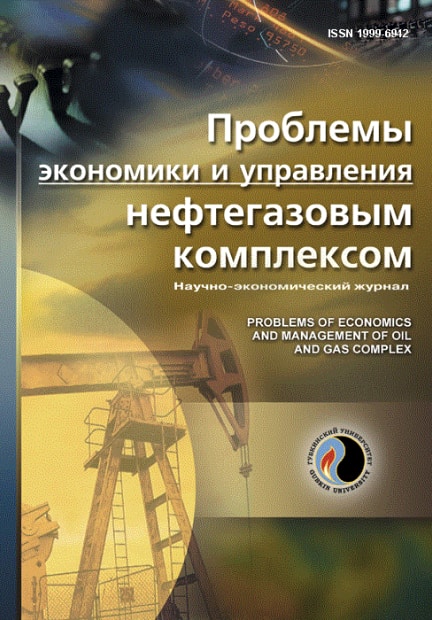Scientific and economic journal
«Problems of economics and management of oil and gas complex»
ISSN 1999-6942

The TINA model in regional hydrocarbon markets: European lessons of strategic sourcing
UDC: 339
DOI: 10.33285/1999-6942-2022-10(214)-5-18
Authors:
1 National University of Oil and Gas "Gubkin University", Moscow, Russia
Keywords: scenario forecasting, oil and gas industry, hydrocarbon markets, EU gas market, TINA model, MIRT-analysis of the life cycle of strategic alternatives, strategic management, P. Kralich matrix
Annotation:
The development of the world economy in the paradigm of modern political and geo-economic realities in which oil and gas companies operate is characterized by a high degree of instability and uncertainty. The sustainable development of oil and gas companies in future depends on their ability to predict and respond flexibly to a changing external environment. It is becoming increasingly difficult to create and maintain competitive advantages in the fight for future markets. The TINA scenario prediction technique is an effective tool for solving such problems. It allows companies to develop and implement a development strategy in the face of complete uncertainty and turbulence in the external business environment. TINA (There Is No Alternative) is a method of forecasting abrupt changes in the economy, in which scenarios are based on dominant trends that are not subject to the growing uncertainty of the external business environment at a particular stage of its development. The strategic situation of TINA is antithetical to the existence of strategic alternatives in the energy markets. The occurrence of such situations is recorded with the help of MIRT-analysis and the crisis in the EU gas market as part of the global energy crisis confirms this fact. Verification of the conclusions of MIRT-an analysis of the lack of alternatives to Russian gas supplies to the EU market as a system-forming part of the volume of supply on it allows carrying out such a traditional corporate management tool as the P. Kralich matrix. In the logic of strategic sourcing, Russian pipeline gas in the P. Kralich matrix belongs to the commodity group of strategic positions, while American LNG belongs to the group of problematic positions, which is ignored by the European Union and its gas strategy.
Bibliography:
1. Ansoff I. Strategicheskiy menedzhment. Klassicheskoe izdanie: per. s angl. – SPb.: Piter, 2009. – S. 142–143.2. Uayli Ya. Al'ternativy net // Iskusstvo upravleniya. – 2000. – № 5. – URL: https://markus.spb.ru/avtoritet/tina.shtml (data obrashcheniya 21.07.2022).
3. Metodika TINA: razrabotka strategii v usloviyakh nestabil'noy ekonomiki. – URL: http://md-hr.ru/articles/html/article32703.html (data obrashcheniya 21.07.2022).
4. Shtopakov I.E., Arshinov G.A. Printsipy otvetstvennogo investirovaniya i rossiyskie neftegazovye kompanii // Mirovaya ekonomika i energetika: drayvery peremen / pod red. S.V. Zhukova. – M.: IMEMO RAN, 2020. – S. 9–10.
5. Sidorovich V. Investitsii neftegazovykh kompaniy v VIE mogut vyrasti do 10% kapital'nykh zatrat k 2030 godu. – URL: https://renen.ru/investment-by-oil-and-gas-companies-in-renewables-can-grow-up-to-10-of-capital-costs-by-2030/ (data obrashcheniya 27.07.2022).
6. Batyrov T. Bloomberg uznal o prizyve Germanii k G7 prodolzhit' investirovat' v dobychu gaza. – URL: https://www.forbes.ru/biznes/469791-bloomberg-uznal-o-prizyve-germanii-k-g7-prodolzit-investirovat-v-dobycu-gaza (data obrashcheniya 26.06.2022).
7. Global Oil & Gas Exploration & Production – Market Size 2005–2028. – URL: https://www.ibisworld.com/global/market-size/global-oil-gas-exploration-production/
8. Mastepanov A.M. "Temnaya" storona dekarbonizatsii ili riski nedoinvestirovaniya v traditsionnuyu energetiku. – URL: https://energypolicy.ru/tyomnaya-storona-dekarbonizaczii-ili-riski-nedoinvestirovaniya-v-tradiczionnuyu-energetiku/novosti/2022/20/25/ (data obrashcheniya 24.07.2022).
9. Shtopakov I.E., Arshinov G.A. Krupnye neftegazovye kompanii i resursno-tekhnologicheskie problemy razvitiya al'ternativnoy energetiki // Problemy ekonomiki i upravleniya neftegazovym kompleksom. – 2022. – № 5(209). – S. 12–22. – DOI: 10.33285/1999-6942-2022-5(209)-12-22
10. 2021: god energeticheskogo krizisa i pereosmysleniya perspektiv VIE. – URL: https://gasandmoney.ru/tendenczii/2021-god-energeticheskogo-krizisa-i-pereosmysleniya-perspektiv-vie/
11. European gas prices soar after Russia deepens supply cuts. – URL: https://www.ft.com/content/f8450175-7332-4074-aaac-71534141e305
12. SShA ne mogut vospolnit' nedostatok gaza v Evrope. – URL: https://inosmi.ru/20220728/gaz-255231469.html (data obrashcheniya 28.07.2022).
13. Buchhoz K. What Alternatives Does Europe Have to Russian Gas? – URL: https://www.statista.com/chart/27004/main-gas-exporting-countries-pipeline-lng/
14. Energokompaniya iz Germanii zayavila o riske dlya edinstva ES bez rossiyskogo gaza. – URL: https://www.forbes.ru/biznes/469663-energokompania-iz-germanii-zaavila-o-riske-dla-edinstva-es-bez-rossijskogo-gaza (data obrashcheniya 28.07.2022).
15. Al'ternativy rossiyskomu gazu net / TsDU TEK. – URL: https://www.cdu.ru/tek_russia/articles/3/1019/
16. Global'nye vyzovy energobalansa – 2022. – URL: https://roscongress.org/sessions/spief-globalnye-vyzovy-energobalansa-2022/discussion/
17. A 10-Point Plan to Reduce the European Union’s Reliance on Russian Natural Gas / IEA. – 2022. – 12 p. – URL: https://www.iea.org/reports/a-10-point-plan-to-reduce-the-european-unions-reliance-on-russian-natural-gas
18. Shtopakov I.E., Arshinov G.A. Zhiznennyy tsikl strategicheskikh al'ternativ krupnykh neftegazovykh kompaniy // Problemy ekonomiki i upravleniya neftegazovym kompleksom. – 2020. – № 2(182). – S. 10–19. – DOI: 10.33285/1999-6942-2020-2(182)-10-19
19. Kraljic P. Purchasing Must Become Supply Management // Harvard Business Review. – 1983. – September – October. – P. 109–117.
20. Van Assen M., van den Berg G., Pietersma P. Key Management Models. The 60+ models every manager needs to know. – 2nd edition. – Prentice Hall, 2009. – P. 144–146.